Johns Creek, Georgia, United States
Architect: Joe Lee (1973), Mike Riley and Chris Cupit (2005)
7,005 Yards, Par-72
Rating/Slope: 74.0/138
My Quick Review: Maybe not a top-100 golf course, but Rivermont is what all golf courses should be - fun and strategic!
I had the great fortune to visit Rivermont County Club last week as the guest of a very generous GCAer. What a wonderful golf course! It is pure fun and shows just what a local private club could be and should be. The bunkering is simple and strategic -- imparting 1/2 shot penalties if found. The greens are varied in shape and size -- the one constant is that every single green is fun. Some have wild internal contours, some rely on tilt, many are angled, and nearly all encourage a running approach.
Some have said that Rivermont is a great local, private club, but not a top-100 type course. Honestly, I say, 'why not'? Every single shot is compelling and thought-provoking. Even after several inches of rain a few days earlier, and sub-freezing temperatures the past few nights, the golf course was in near-perfect condition, allowing for running shots -- the maintenance meld was a perfect fit for the architecture. Aside from Peachtree, I've now played all 'top-100 contenders' in the Atlanta area, and without a second thought I'd return to Rivermont over any of them. So, to those who disagree, why isn't Rivermont a top-100 course? (and I'll spot you the fact that it is a very difficult walk).
It's not surprising that a club owned by a GCAer has attracted so many GCAers as members. Golden Age strategic design is alive and well at Rivermont.
I'm going to post my photo tour 3 holes at a time. Photos will be from the one off the back, white tees (about 6,500 yards). The tips can now stretch to near 7,200 yards.
The opening par-4 is demanding from any set of tees, but is a monster from the back tees (pictured below). From the tee it is clear that this green is best approached from the left, but a stream running down that side of the fairway, combined with the fairway's leftward tilt, make it difficult to play for anywhere but the right side.
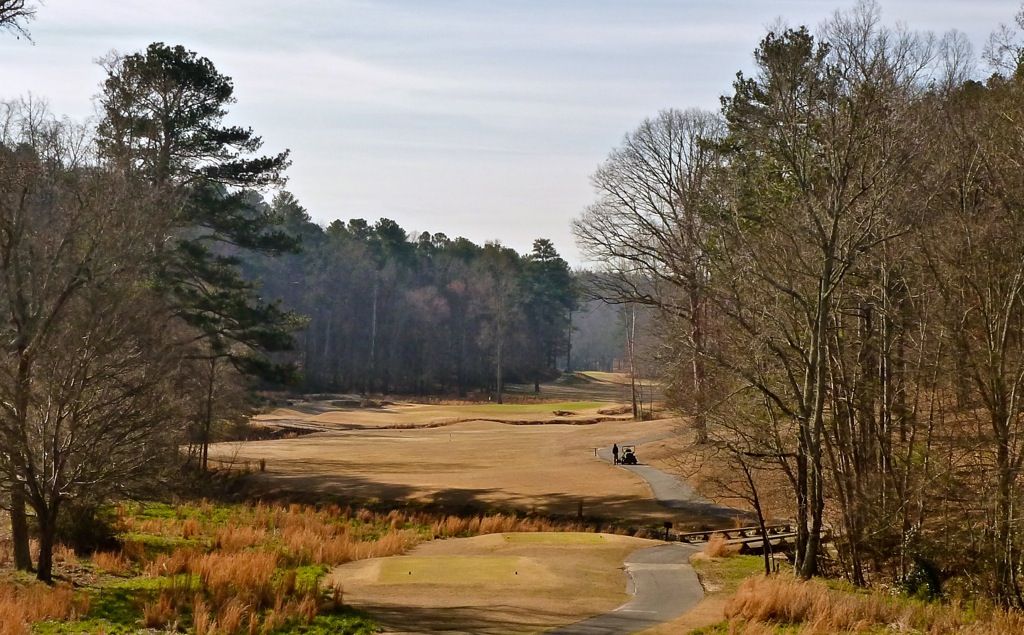
Front pins, as pictured, can be approached from anywhere, but accessing the right side of the green is a difficult task.
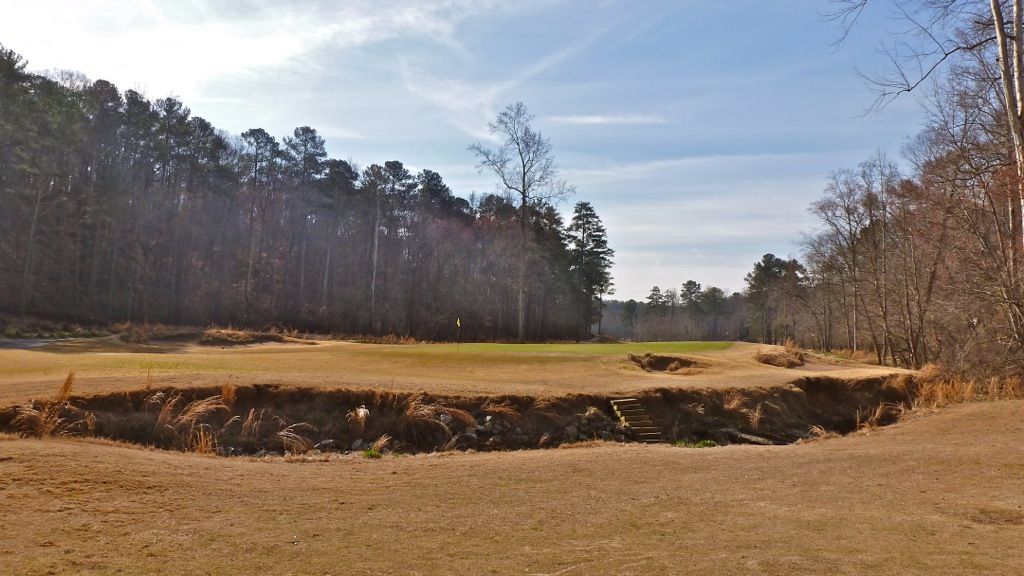
The second is a 530 yard par-5. Is that some reverse-cambre? Why, yes it is! Golfers are asked to play down the left side of the fairway or risk bounding through the fairway on the right. A 3-wood from the tee, especially for those unable to get home in two, is probably the way to play this hole.
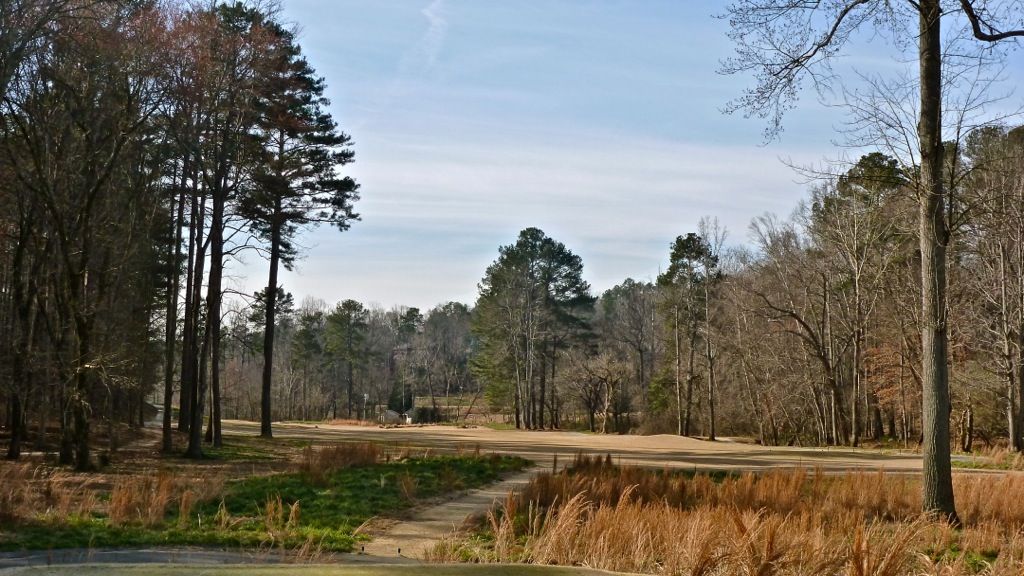
The right side of the lay-up area is guarded by a bunker that protects the ideal line into the green. Approaches from the left will be blind, blocked-out by bunkers/mounding.
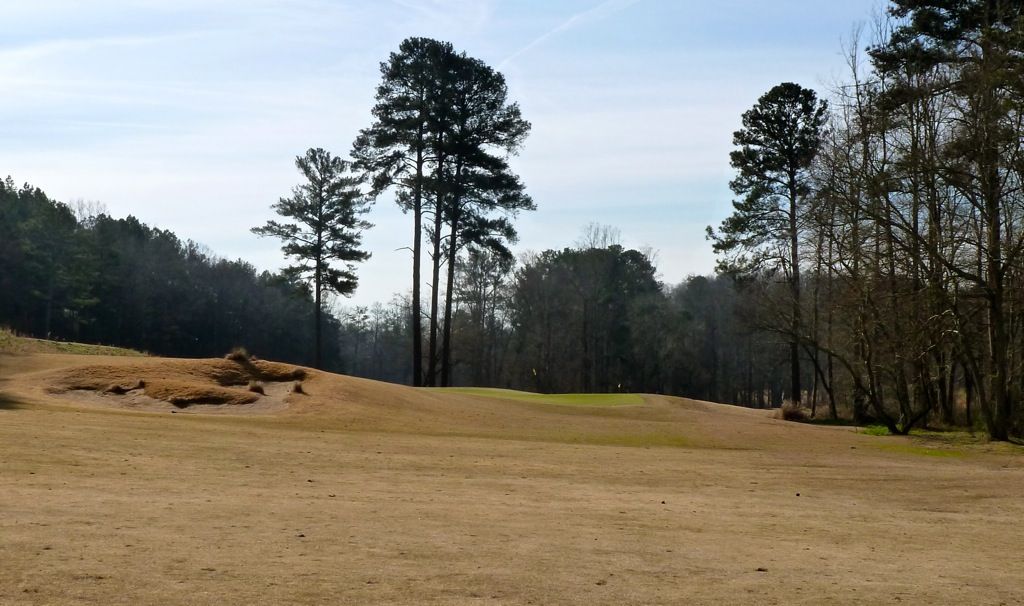
The mound on the left is a very cool feature as it lays 40 yards short of the green. Golfers familiar with the course can use its contours to kick balls onto the green.

The contours on the 2nd green are amazing. Depending on the pin and the shot played, the contours can either be used to funnel balls toward the pin, or you will be stuck, frustratingly watching the contours take the ball farther and farther away from the pin.
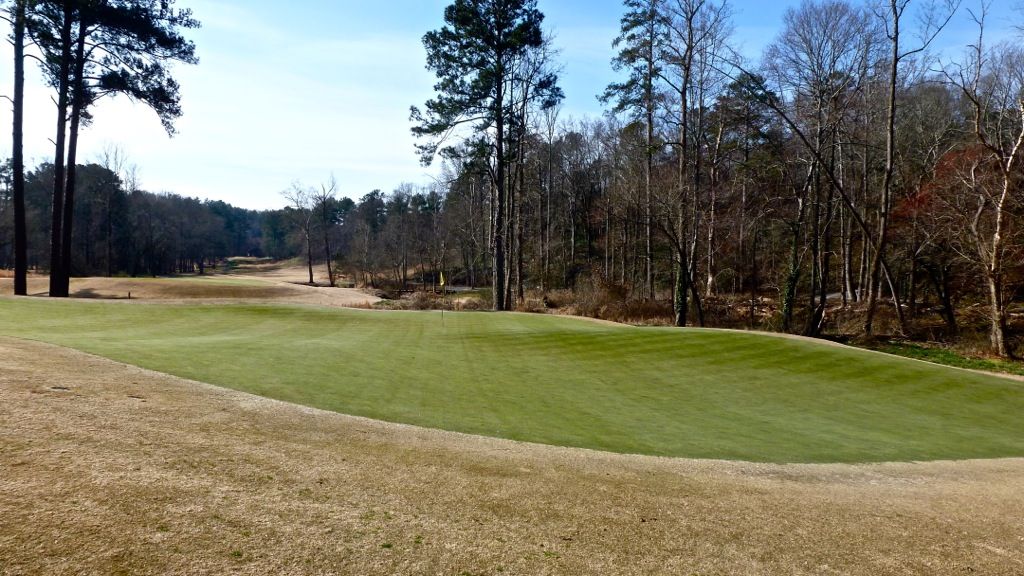
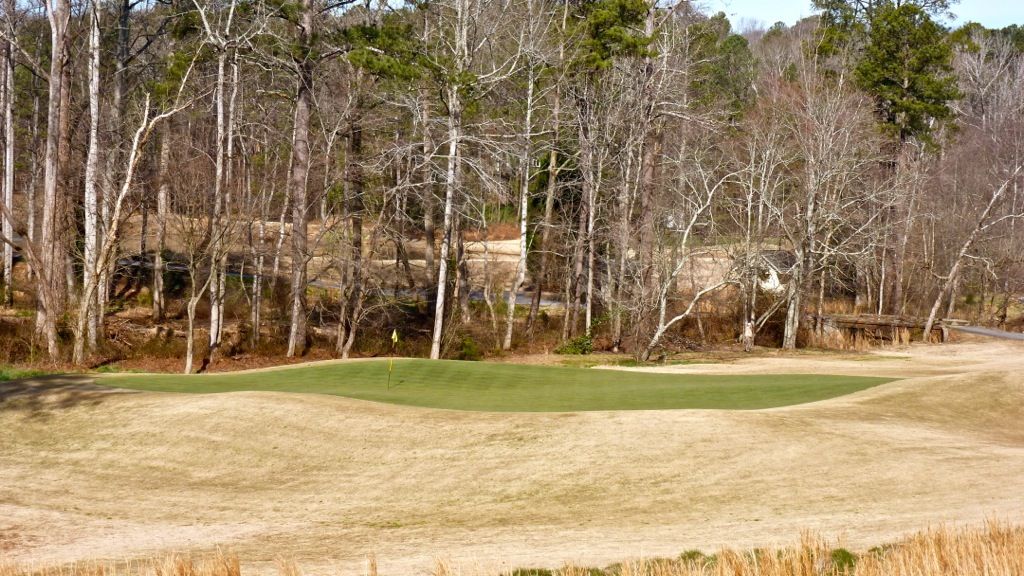
The 3rd is a mid-length par-4 that, like the 1st and 2nd holes, uses the tilt of the land to add to its strategic interest. Golfers will want to play to the high side of the fairway to leave a preferred angle into an angled green.
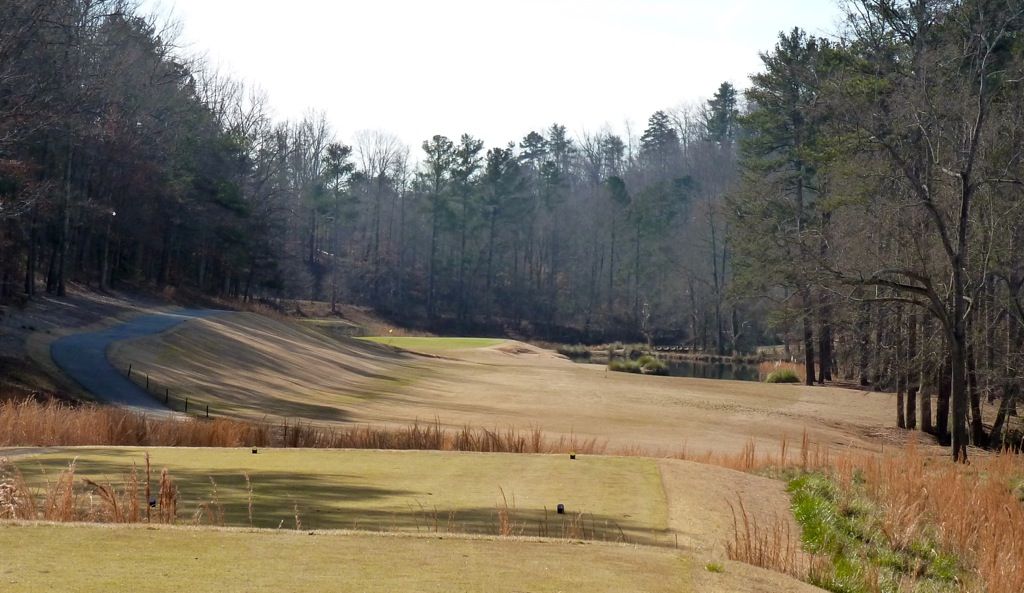
A perfectly played tee shot leaves a simple approach to an open green front.
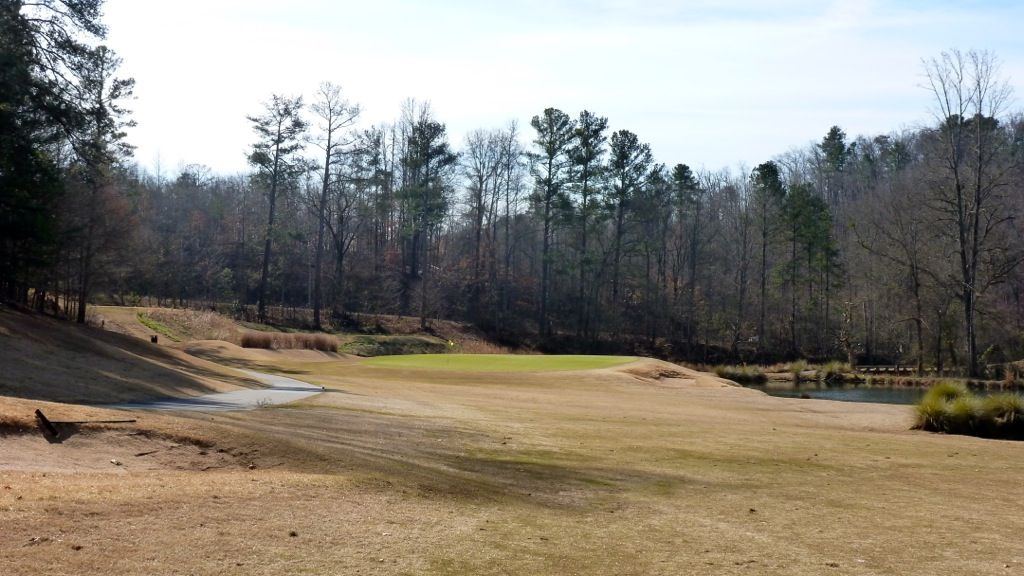
As seen from the 4th tee, the contours on the 3rd green are subtler than on the first two greens. The green tilts generally from back-to-front, but a devilish knob on the front left corner and a shelf back-left can make for some difficult recovery shots.
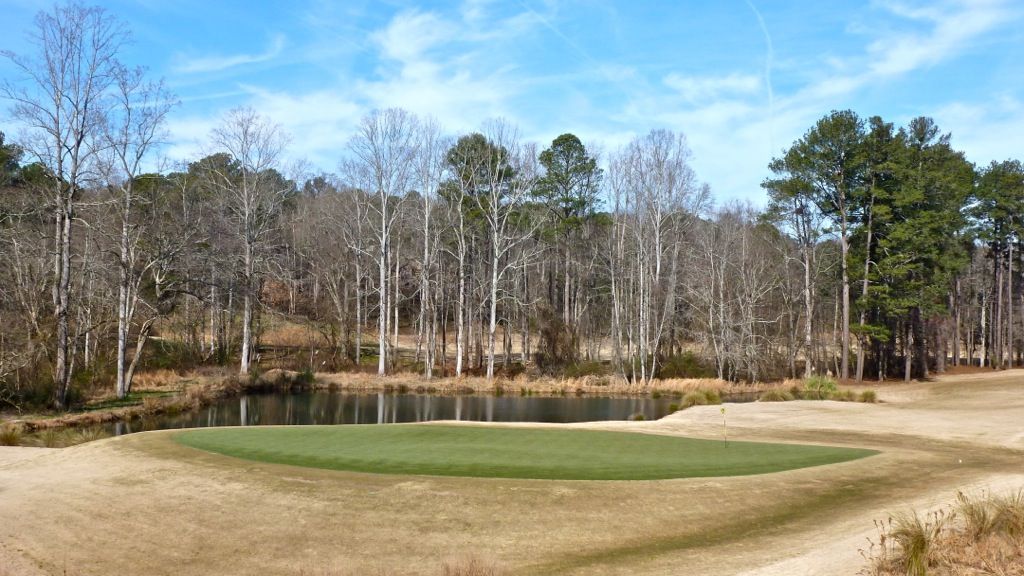
The fourth hole is one of the most changed holes on the course (from what I can tell, based on aerials). Mike Riley and Chris Cupit completely changed the orientation of the green and the bunker scheme to create one of the best functioning redans I've ever played.
Before:
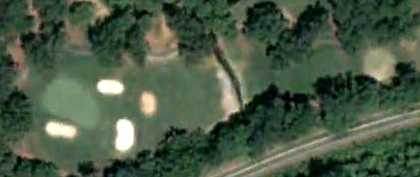
After:
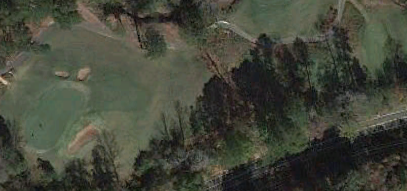
A series of Mike Riley's sketches hang in the clubhouse. They are awesome and anyone with even a mild interest in GCA will love looking through them:
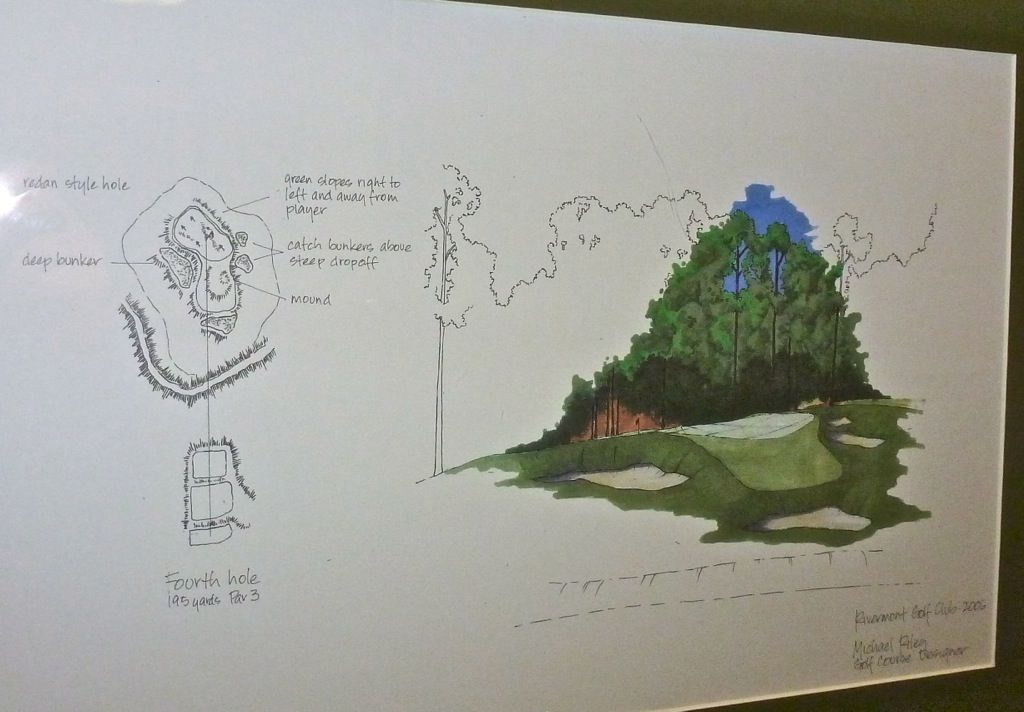
As mentioned, the 180 yard fourth is a well-functioning redan. Shots landing anywhere on the right side of the green will funnel left, while low/drawing shots will catch the full effect of the contours and run all the way down to the back-left portion of the green.
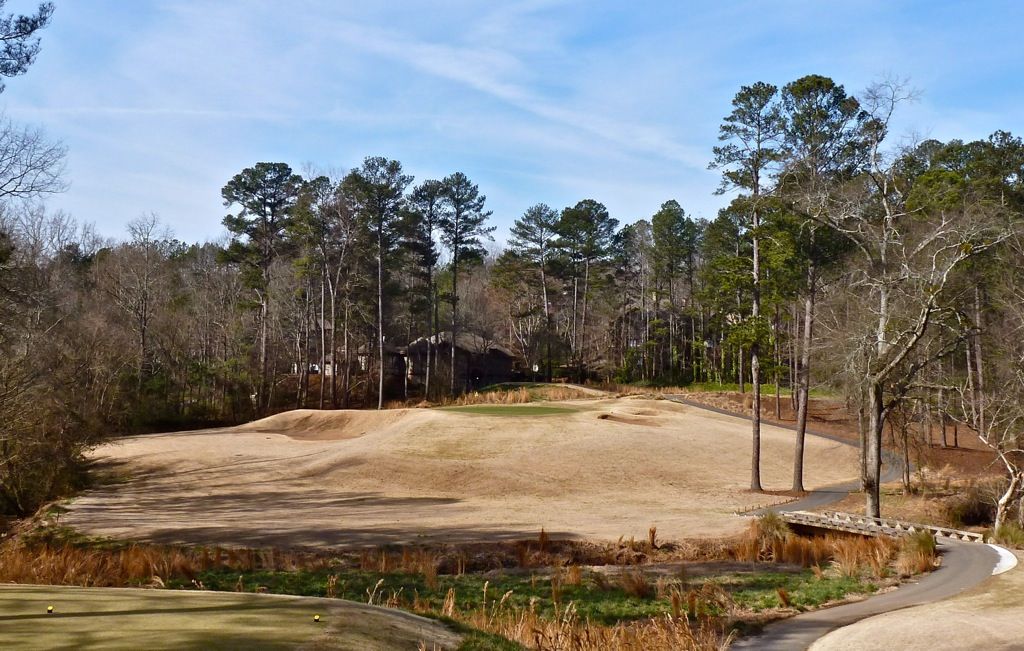
The front-left bunker is fearsome, but as is the case with most redans, not a terrible miss as recoveries from there play into the slope of the green.
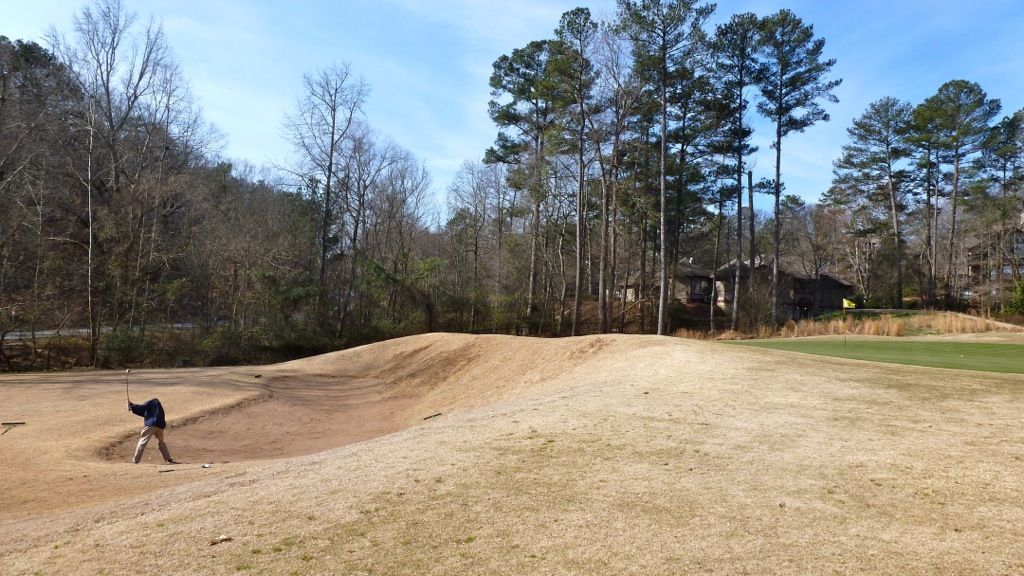
The green as seen from front-right. Hard to capture the tilt of the green.

The 5th is another very changed hole, as the green was moved some 100 yards from short-left of the creek to beyond and right of it.
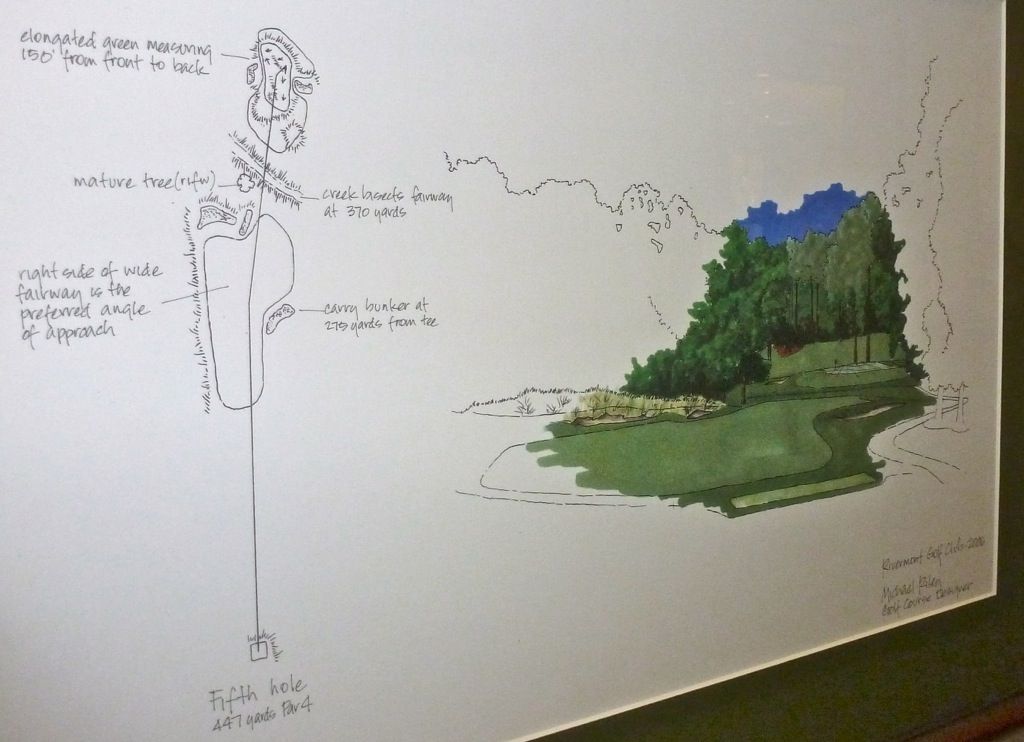
The 410 yard 5th is really strategic design at its best. A carry bunker sits on the right side of the fairway, and which needs to be challenged to leave a reasonable approach into this angled and tilted green.
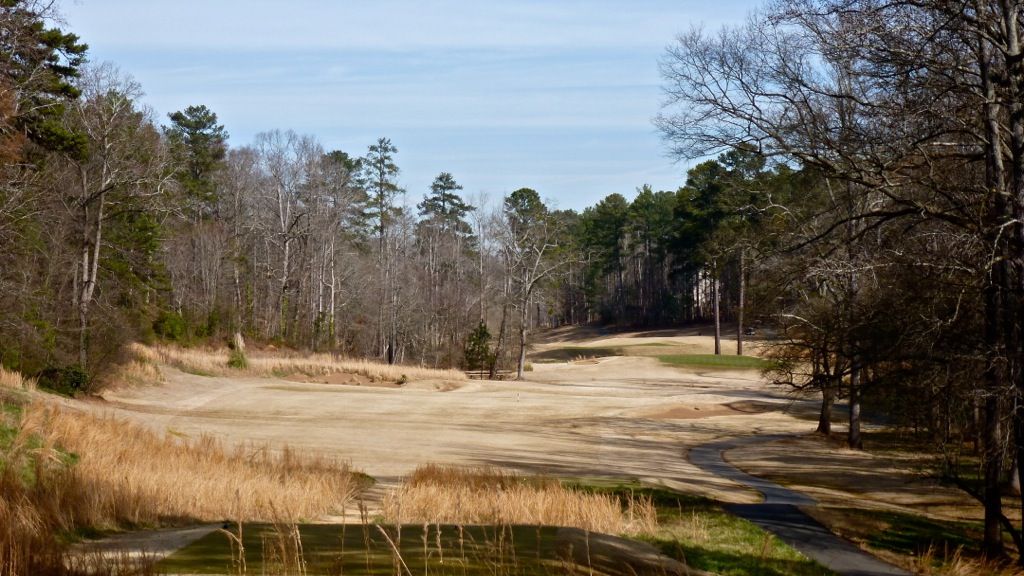
My host once told me that he would rather play from the fairway bunker on the right than approach a back pin from the centre of the fairway. Obviously, this statement was questioned and really not understood. Now that I have played the hole, I fully agree. Approaching from the centre of the fairway is a very difficult task as the green runs away from this angle.
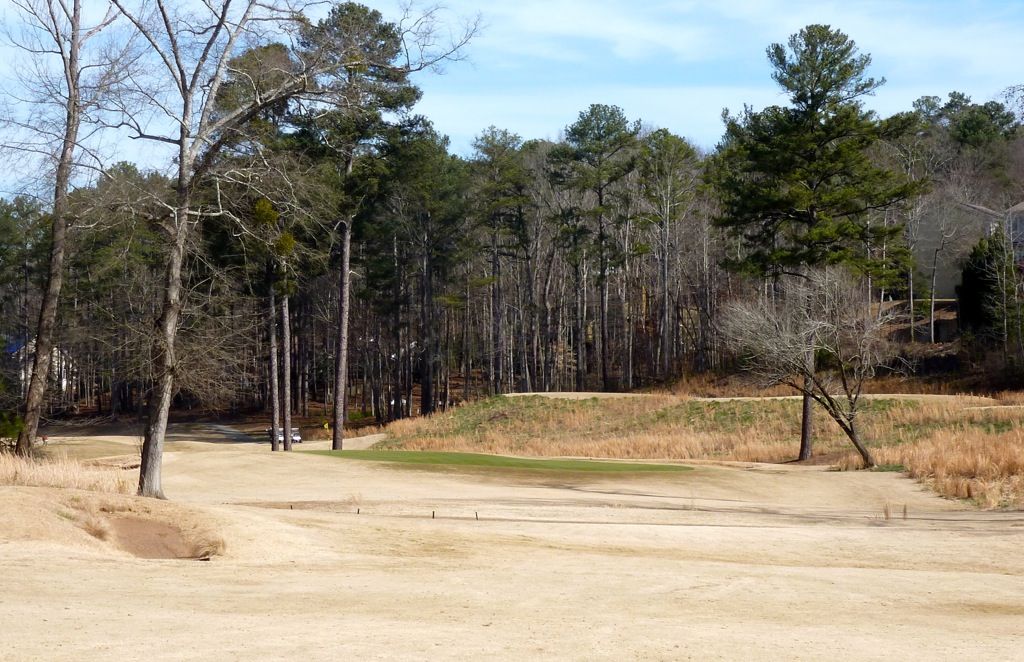
Approaching from the right side of the fairway is a more manageable task.

Two rolls in the green help to shed approaches from the left away from the putting surface. Another great green.
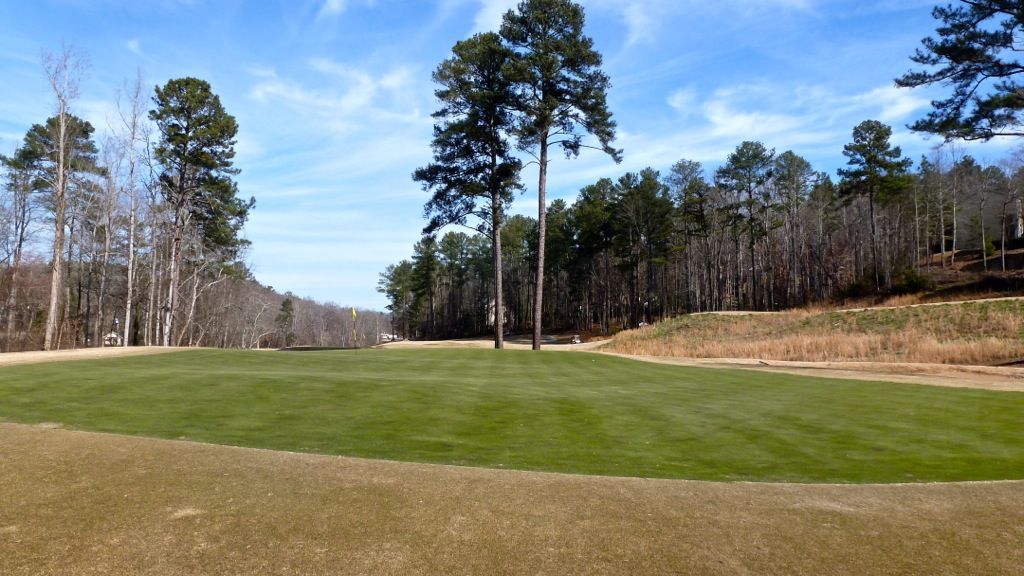
When I first saw a picture of the 160 yard par-3 6th, it reminded me of the 8th at Sebonack in that the pond did not fit well with the rest of the golf course. Like the 8th at Sebonack, this hole has a WILD green.
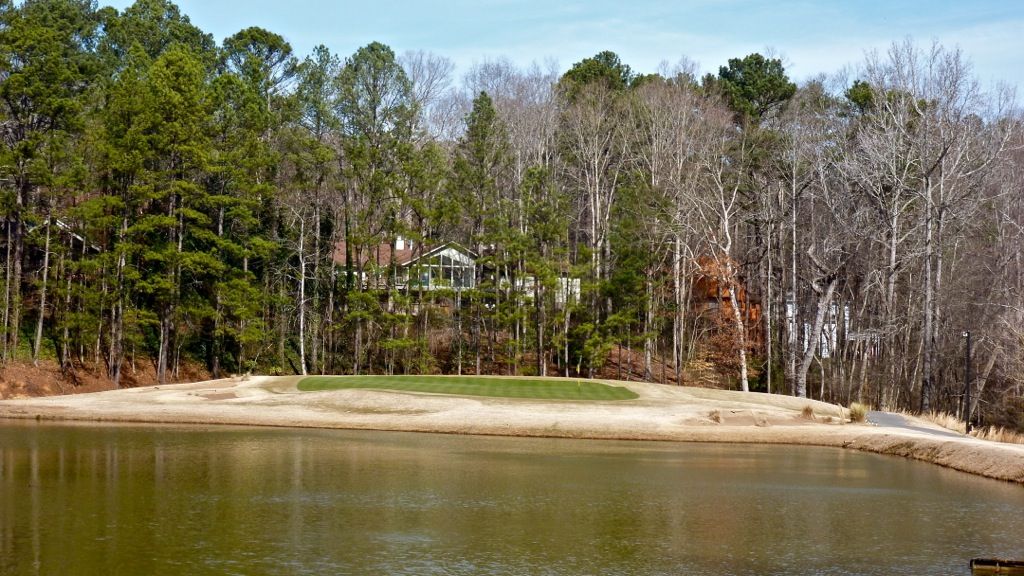
As seen from the front-right corner of the green, shots near the left perimeter of the green will funnel off of the green and a small backboard can be used to access front pin positions.

The real excitement is found past the green's mid-point. A ridge runs across the green's centre, and forms half of a deep half-pipe in the back portion of the green. Back-right is a green hole in one pin position. Too bad I found it when the pin was in the front.
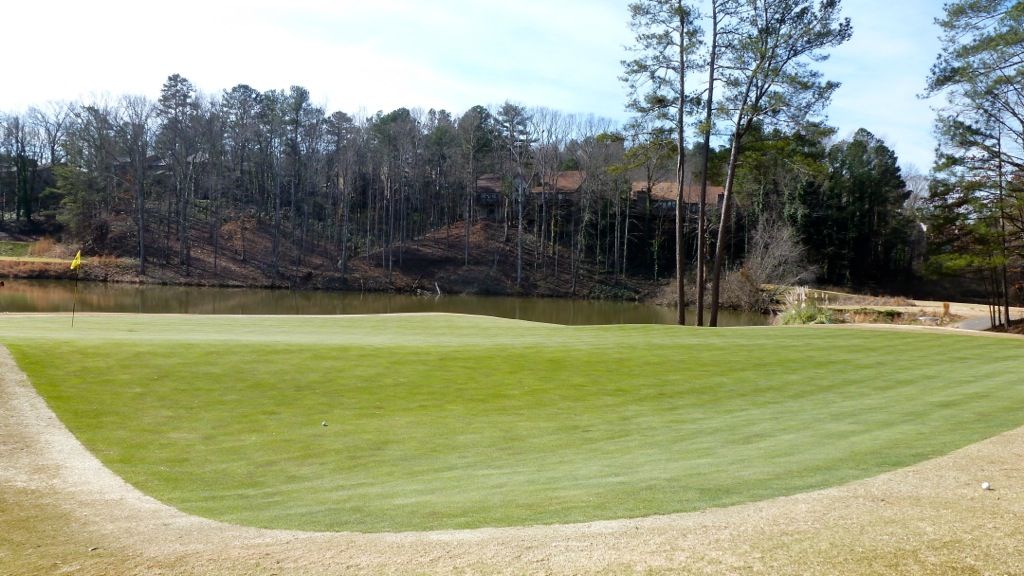
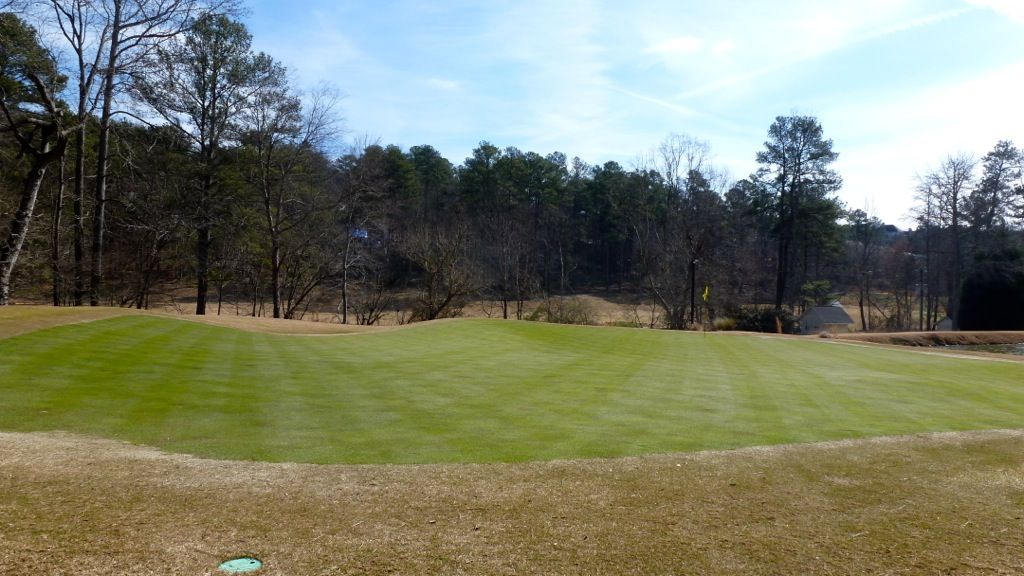
The 7th is a 500 yard uphill par-5 where the golfer that plays near the creek that runs down the left will gain a significant advantage. Fortunately, the right to left tilt of the land assists those that bailout to the right from the tee.
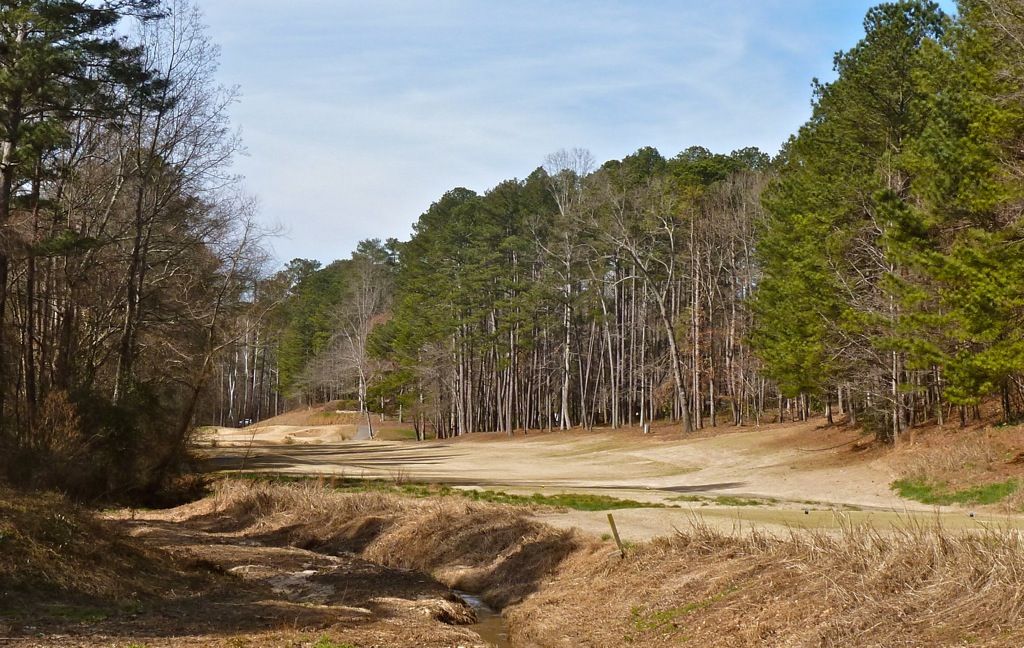
A creek runs diagonally across the fairway near the 150 yard marker. Golfers that mis-hit their tee shot will have to negotiate a lay-up, while those that played their tee shots to the right side of the fairway are left with the longer forced carry.
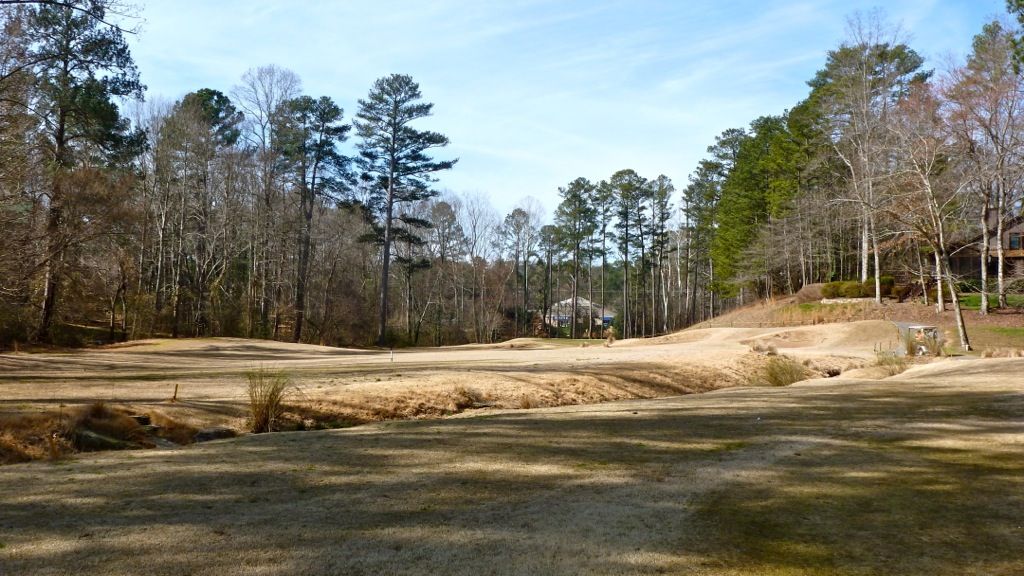
The green tlits significantly from back-to-front and this small carve out at the back-left portion of the green makes for a great Sunday pin position. How much tilt is there? Let's just say that both of my playing companions putted it from above the pin to 15 feet off the front of the green.
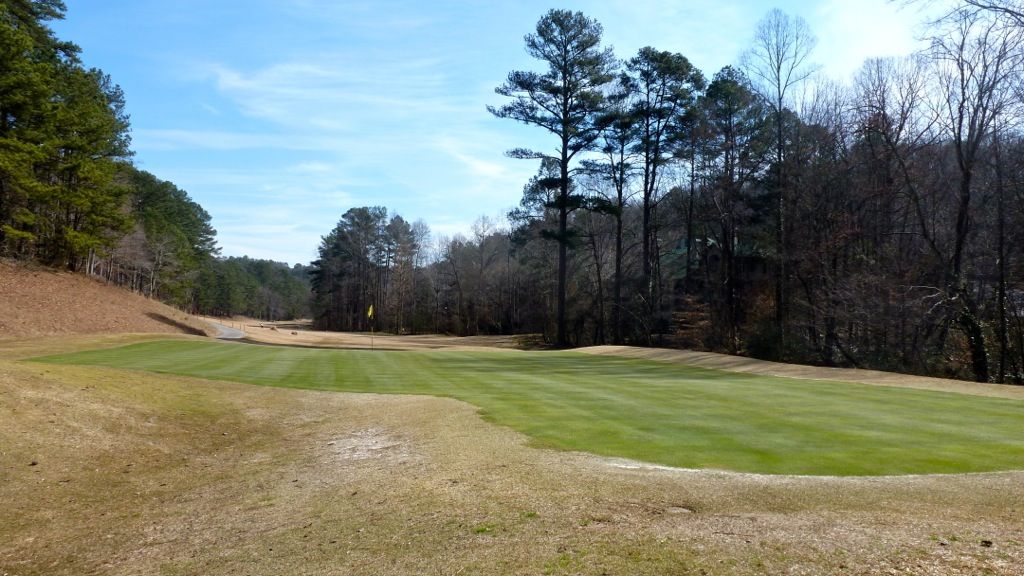
The par-4 8th offers split tees. The first picture is from the newly-added 490 yard tee where a cool top-shot bunker gives a line from the tee:
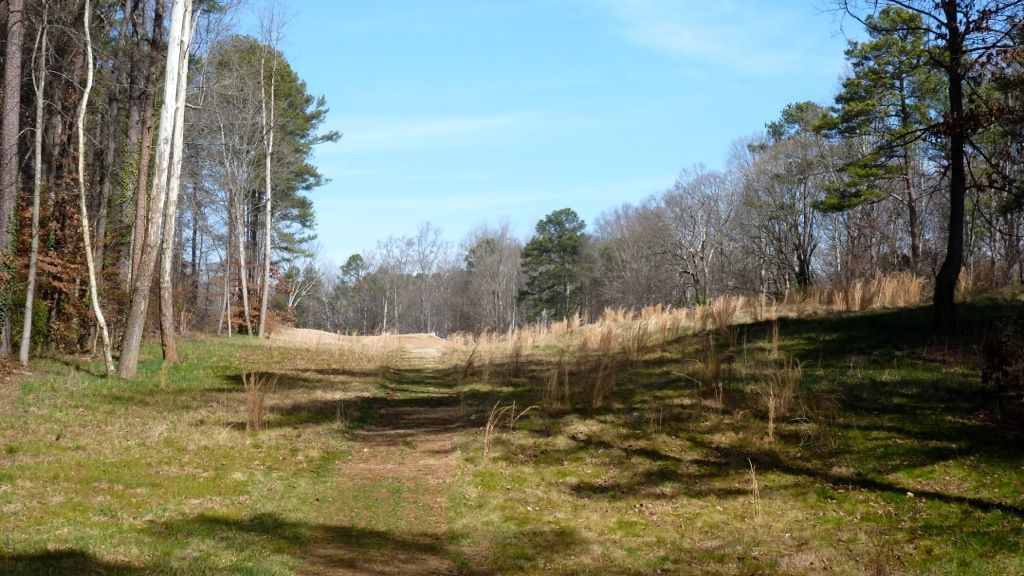
From the members tees, the hole plays a more manageable 400 yards. The tee shot is played downhill to a fairway that falls away to the right, before ascending to another wonderful green.
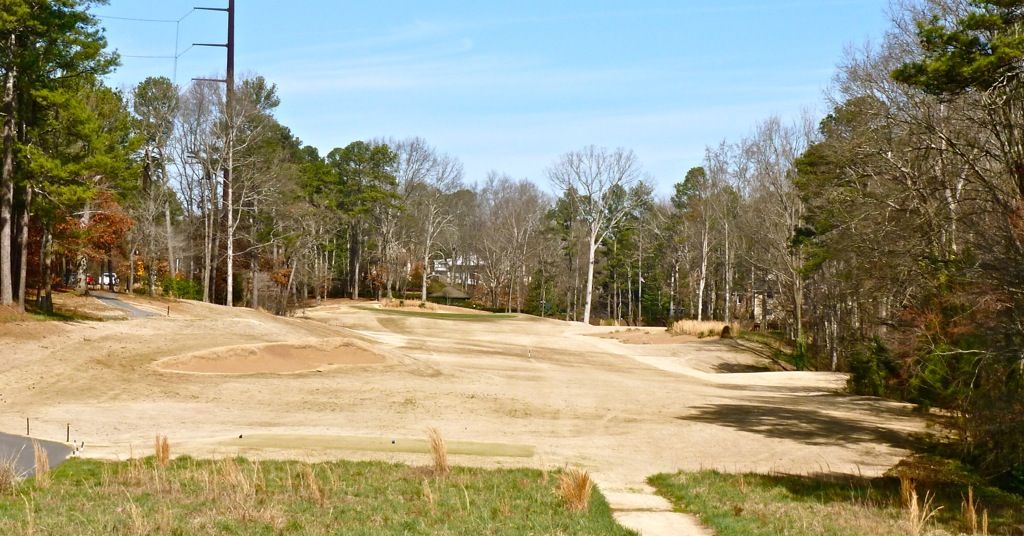
A false-front awaits, ready to catch shots landing on the front portion of the green, and a swale on the right side of the green collects many well struck shots to the green's right perimeter.

Like the 8th, the 360 yard 9th is a down and up par-4. Golfers must choose whether to lay-back to the width of the fairway short of the fairway bunkers, or play to the narrow, inclined part of the fairway around the 100 yard marker.
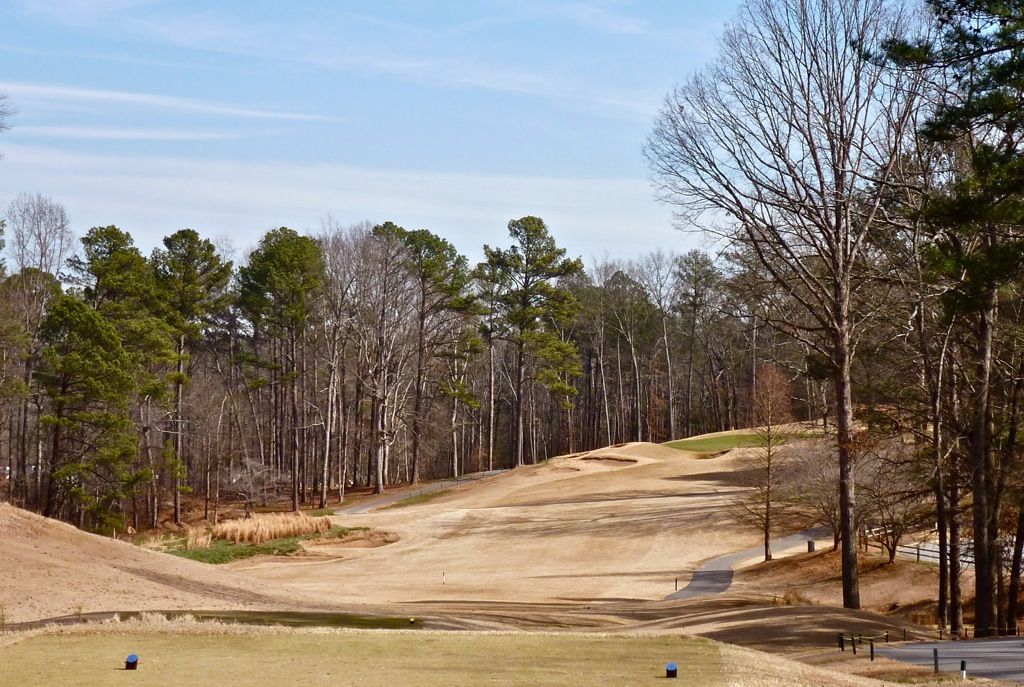
The longer the tee shot, the better the view of the green. An alps-like feature anyone?
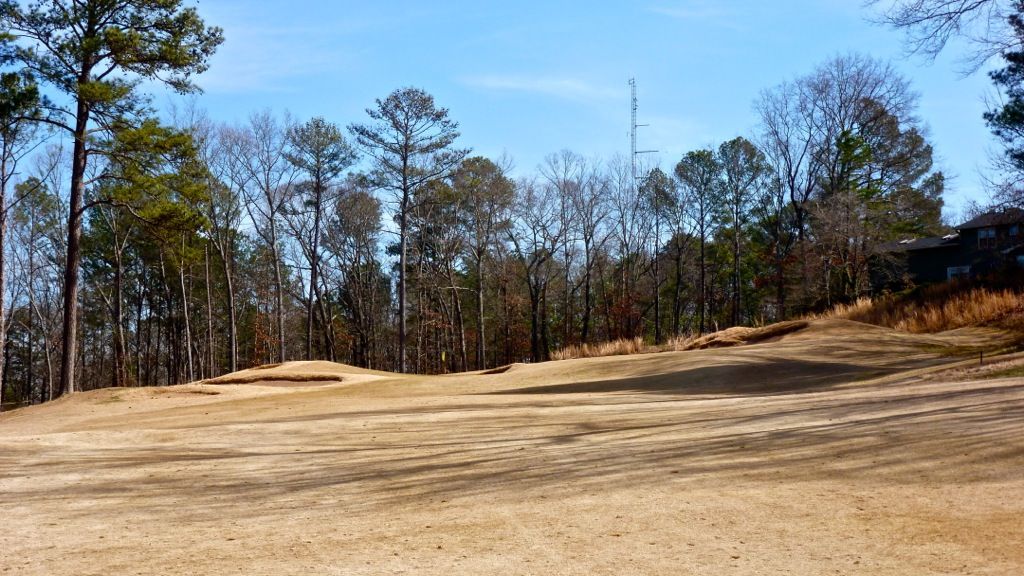
And upon cresting the hill, the golfer gets his first view of the punchbowl green. An alps-punchbowl combo, now where have I seen that before?
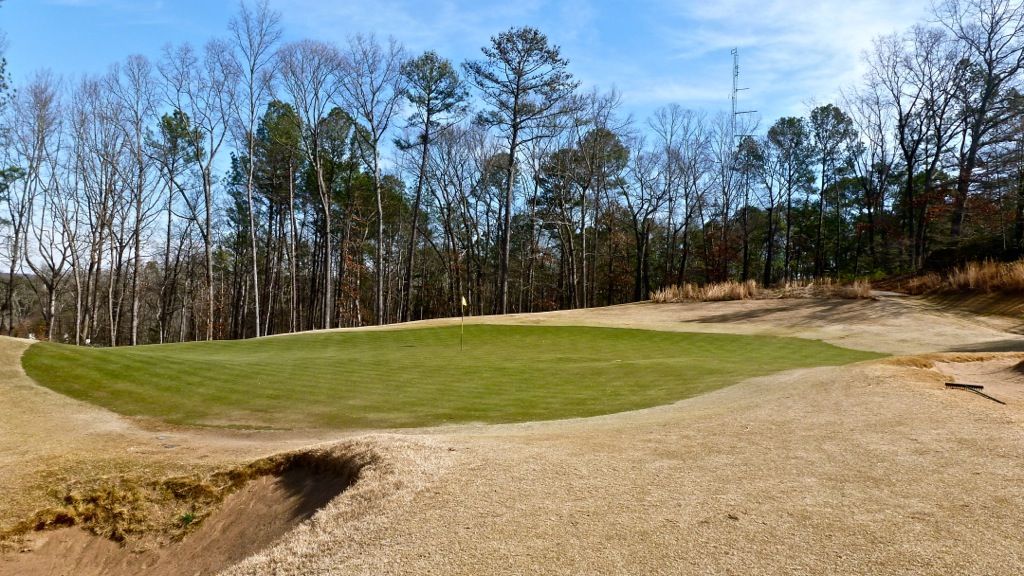
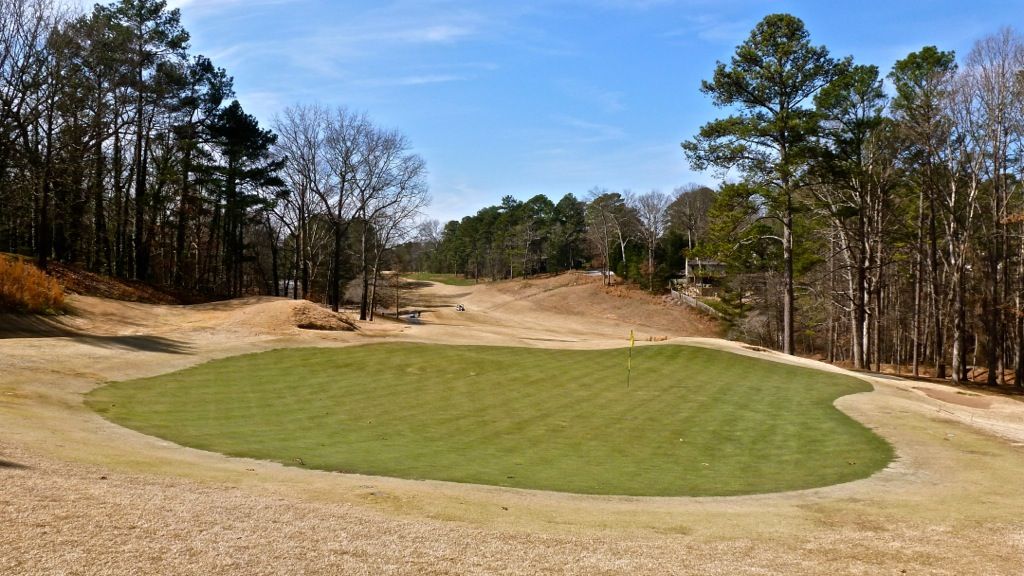
After a lengthy transition from the 9th green to the clubhouse, the back-nine starts with one of my favorite holes on the course. The 10th hole is is a 500 yard double dogleg (almost triple dogleg) par-5, that first moves right, then left, and then right again at the green. While the tee shot has a constrained feeling with trees on both sides, there is more room than there appears and golfers hoping to reach the green in two shots must challenge a single bunker on the inside of the dogleg.
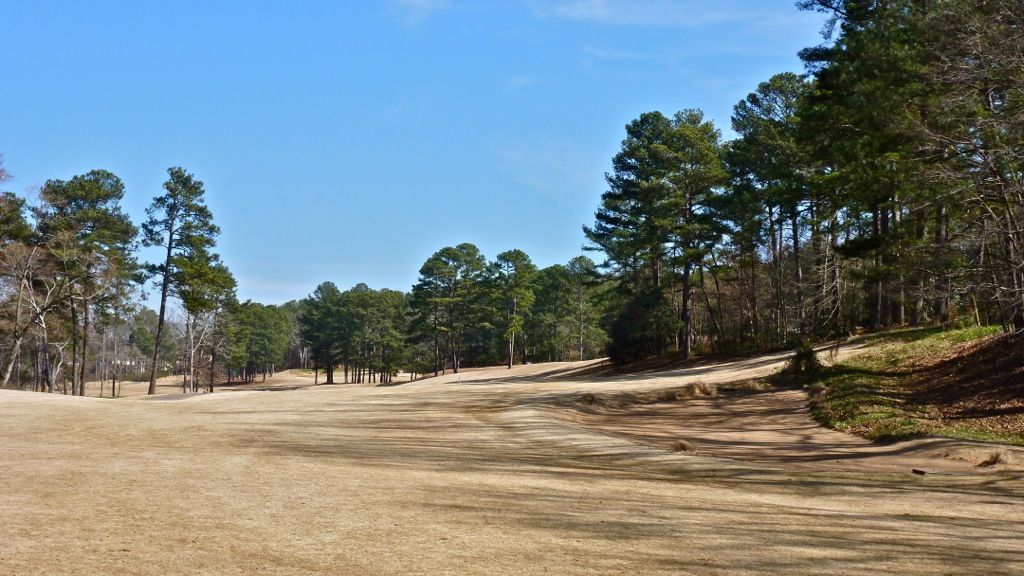
The second for most will be a lay-up but it is one that grabs your attention. The golfer must play near a lone left-side fairway bunker or he will face a difficult wedge shot approach over a bunker from the right.
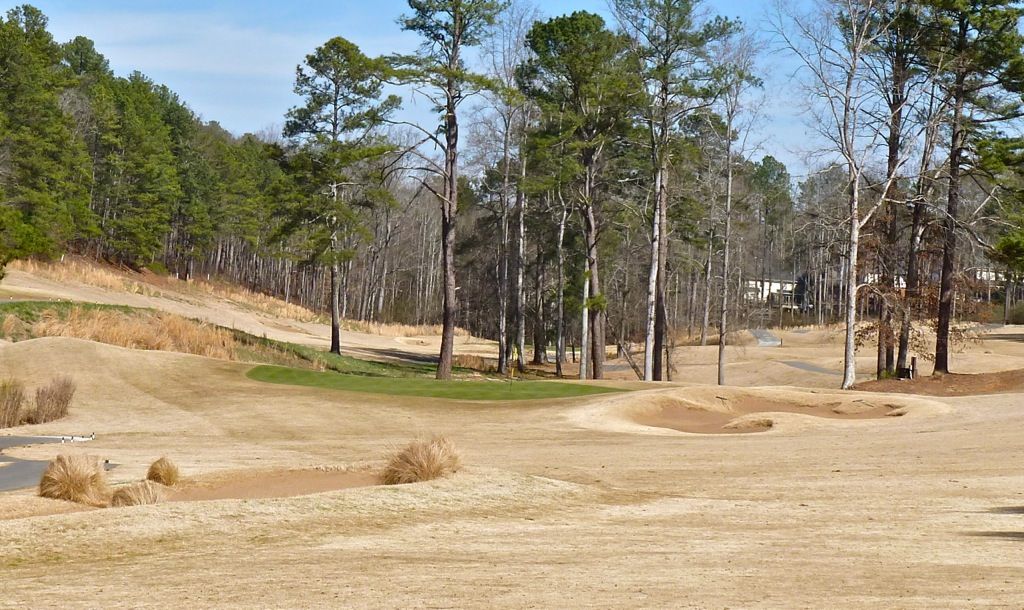

The 11th is a very tempting short par-4 that plays to just over 270 yards from the members tees. At that yardage (remember, only 255 or so to the front edge) and without the overt water hazards that front so many short par-4s, many golfers will have a go at this green, probably finding one of the short bunkers and walking off with 5.

A lay-up away from the stream/bunker on the right leaves an approach that demands precision as the green lay at an angle from here.

The 11th green as seen from the 12th tee, shows the subtle but present internal contouring. For reference, the old 11th green (I believe) was somewhere amongst the bunkering shown below.
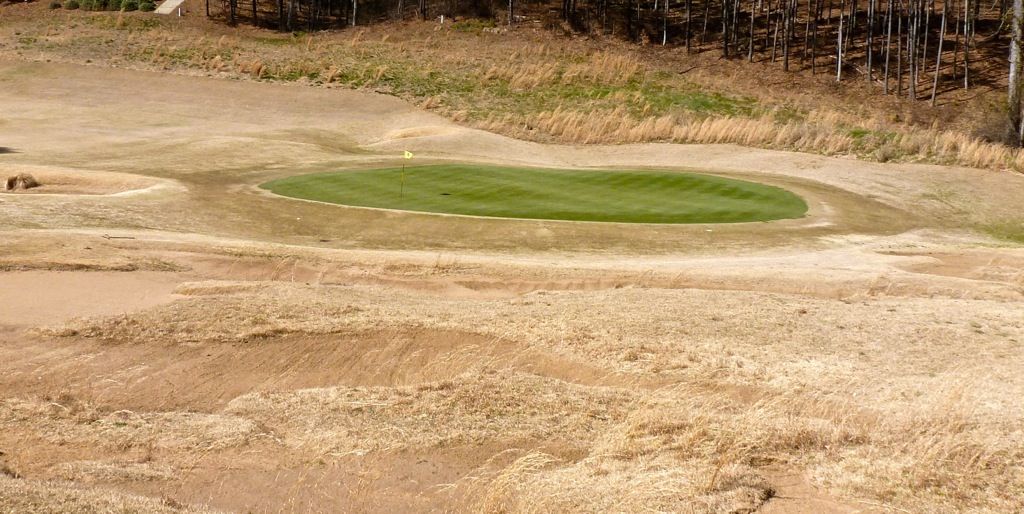
Another really good par-5 at the 12th. The day I played it, the members tees were up one set, making this a very reachable par-5, but the normal tee shot is back and left of the location pictured and from there it is clear that the reverse-cambre will wreak havoc on those unable to draw their tee shot.
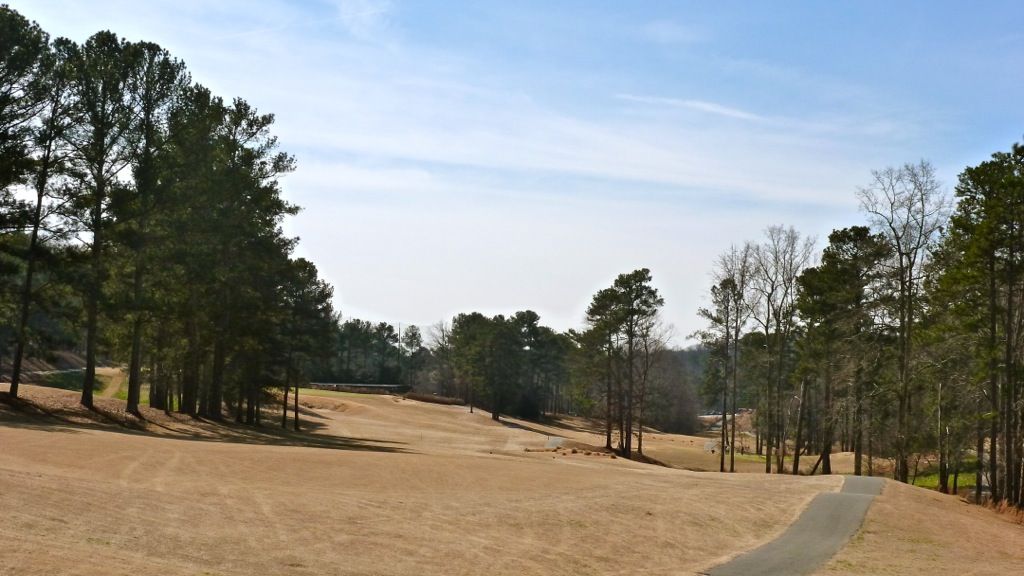
The second shot as seen from around the 200-yard marker. The Big Bertha bunker on the left reminds me of the similarly named bunker short of the 8th green at The Honors in Tennessee, and the golfer will do everything in his power to avoid it (which includes pushing his second shot well to the right and onto the 10th fairway).
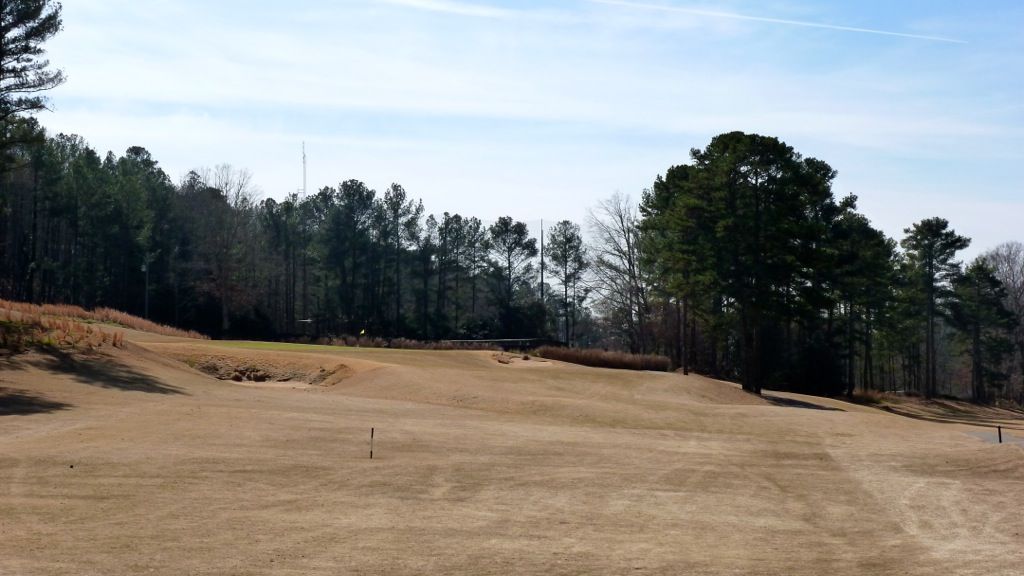
Pictures of this green are almost a waste of time. The back portion of the green is as severely tilted as anything I've ever seen. I had a 10 foot downhill putt from above the hole, which after the first time hitting it 15 feet by the hole, I then tried putting it backwards and even then it went a couple feet beyond the hole. Equal parts fun and frustrating! Next time I won't be above the hole.
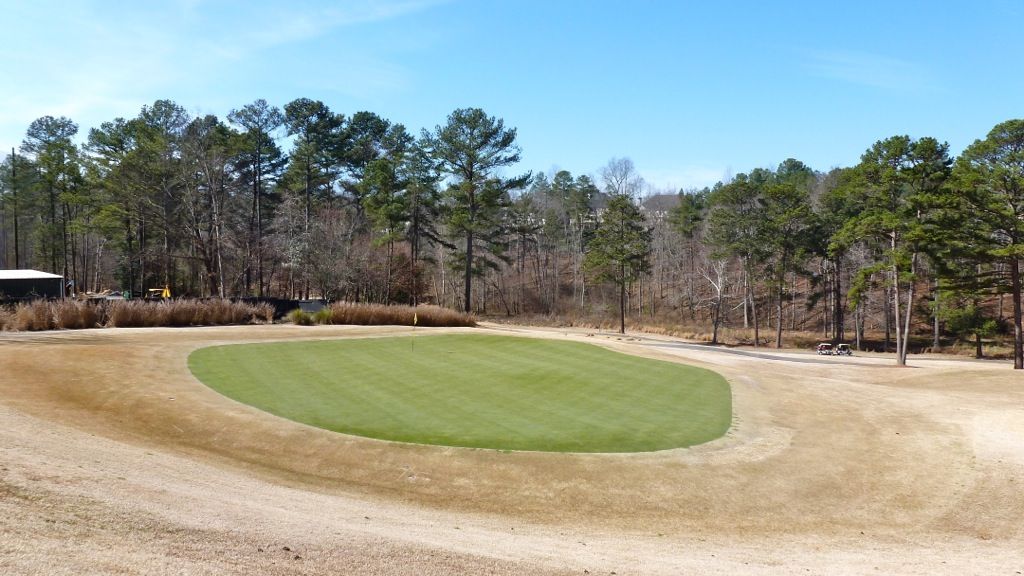
The 13th is a short par-4. The golfer is asked to challenge the bunker guarding the high side of the fairway. From there the golfer has the best view of the green and his approach will be played from the only flat area on the fairway.
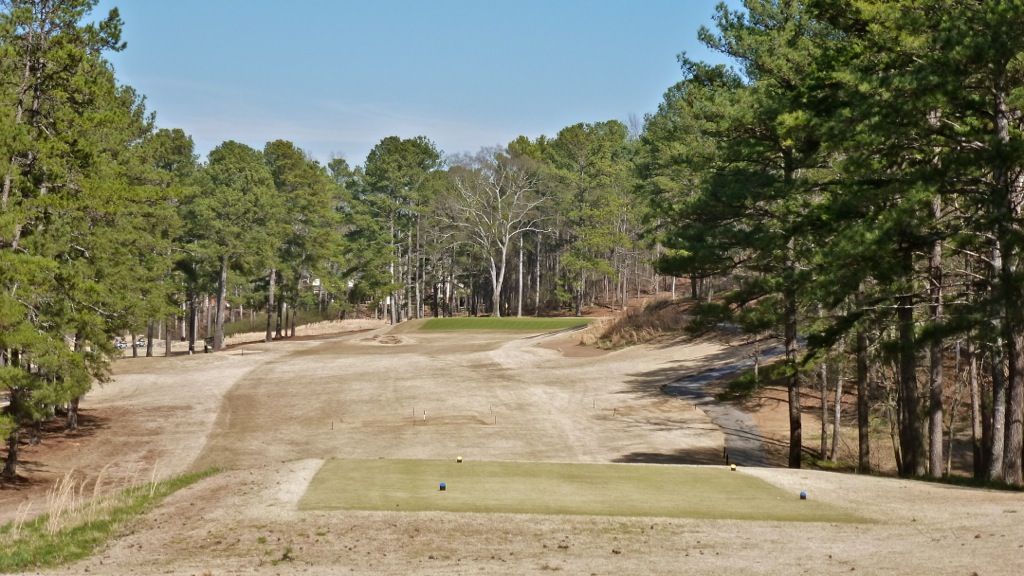
Probably the largest false-front I have ever seen. A ridge cuts across the green half-way back and anything landing short of this ridge will funnel back off of the green.
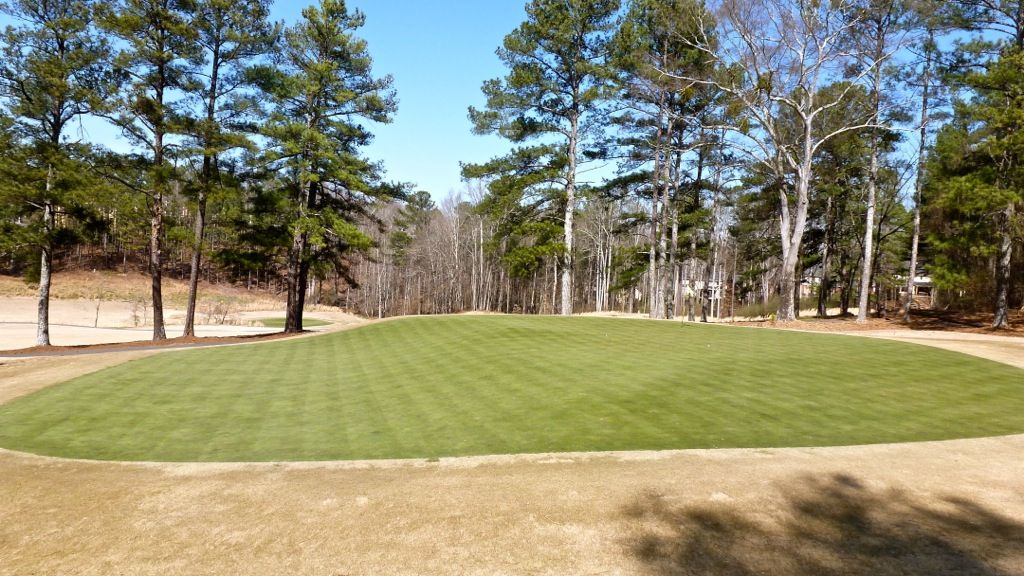
Depending on pin position, this hole may be a breather. But, with a green that has small ledges on the left and back portions of the green, bogey is a real possibility.
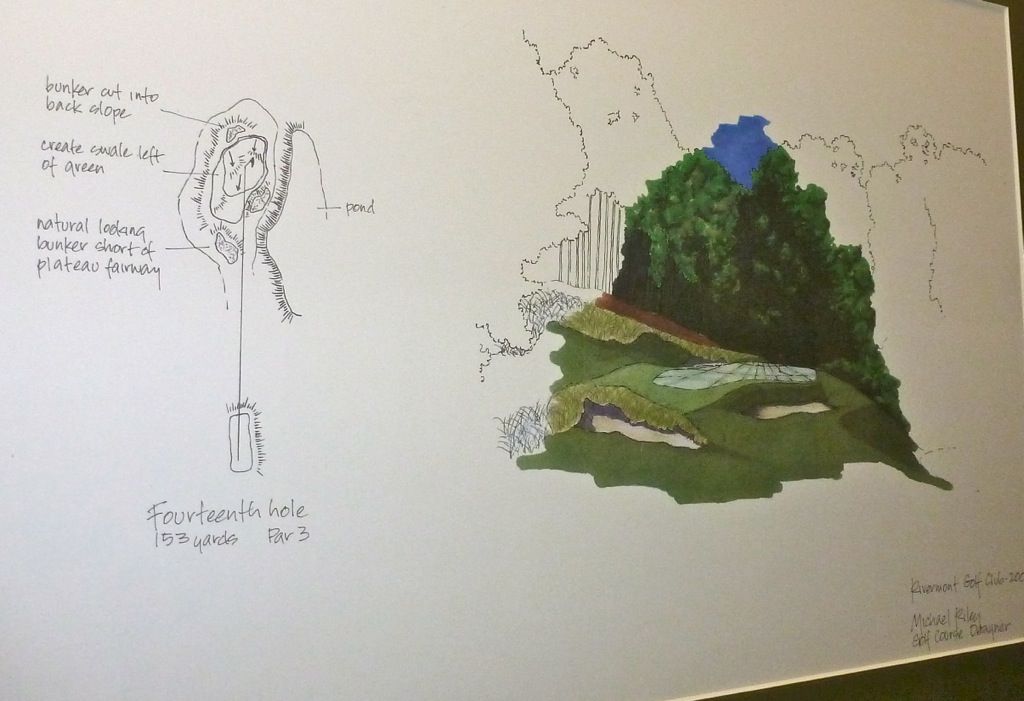
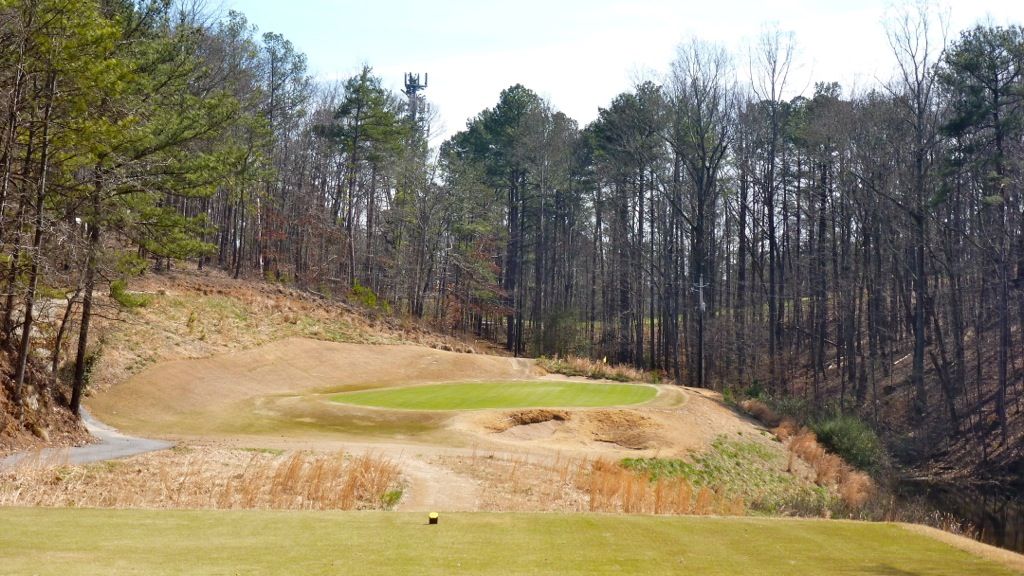
The 400 yard 15th is a very cool and very demanding golf hole. An intimidating view from the tee, as the drive is blind played over a top-shot bunker that is 150 yards to carry.
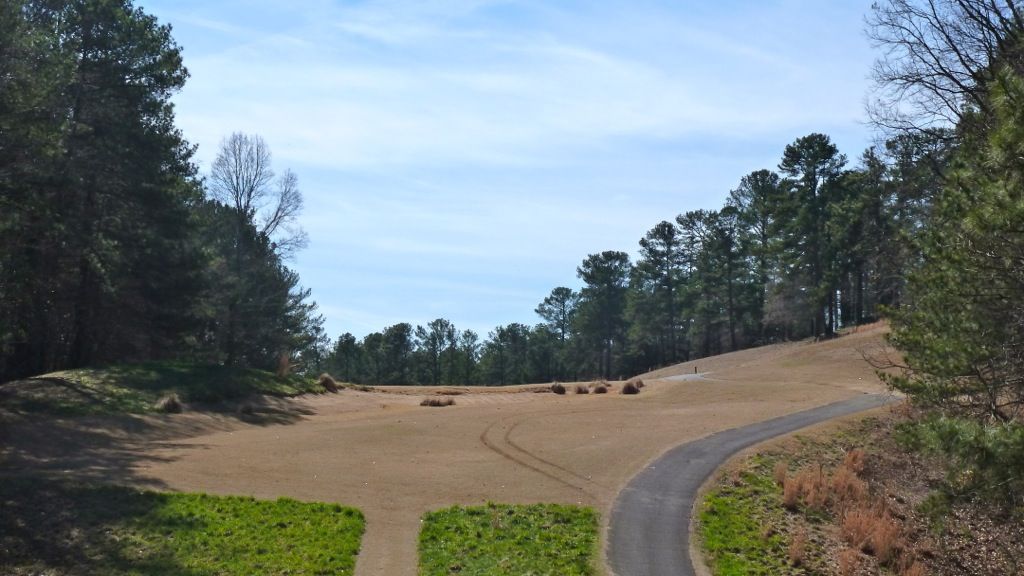
Once in the fairway the golfer is asked to play a running shot from the right, using the ground's contours to bring the ball onto the putting surface.
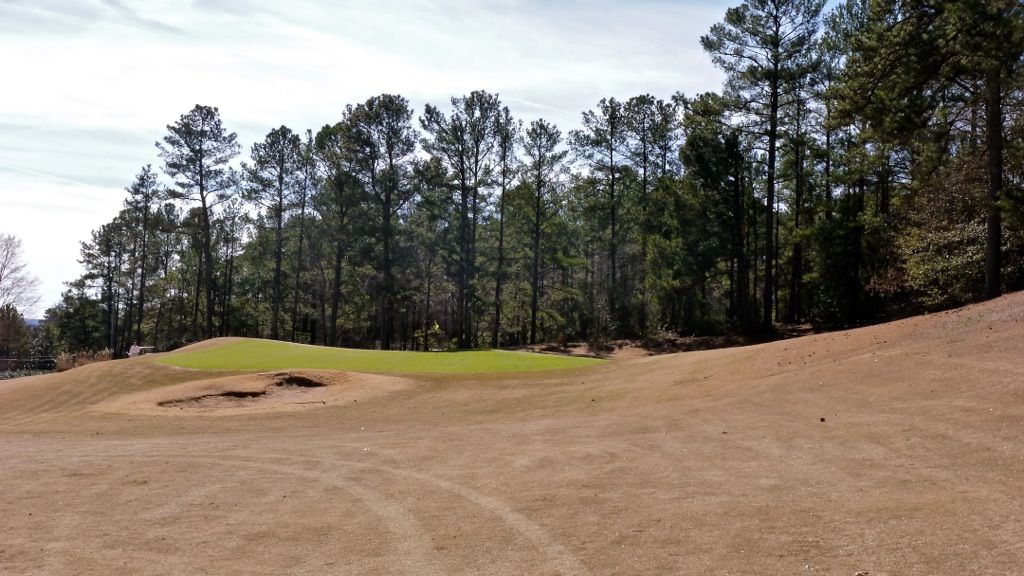
With MacRaynor inspired straight lines and sharp drop-offs, missing left of the greensite is a terrible mistake.

The extreme back-left portion of the green is mowed all the way up and into the ridge around the green. Only at Tillinghast's Quaker Ridge have I seen this. The green generally slopes from right-to-left, but there is counterslope on the left portion of the green to protect shots coming from the right from running all the way though the green.
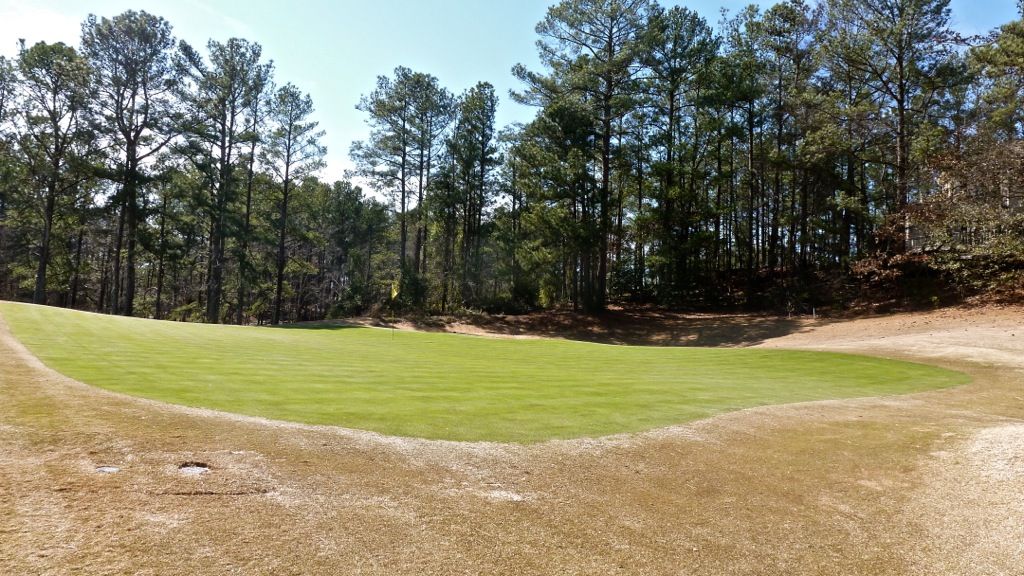
The 16th hole is one of the very best on the golf course and uses the lay of the land and strategic bunkering to maximum effect.
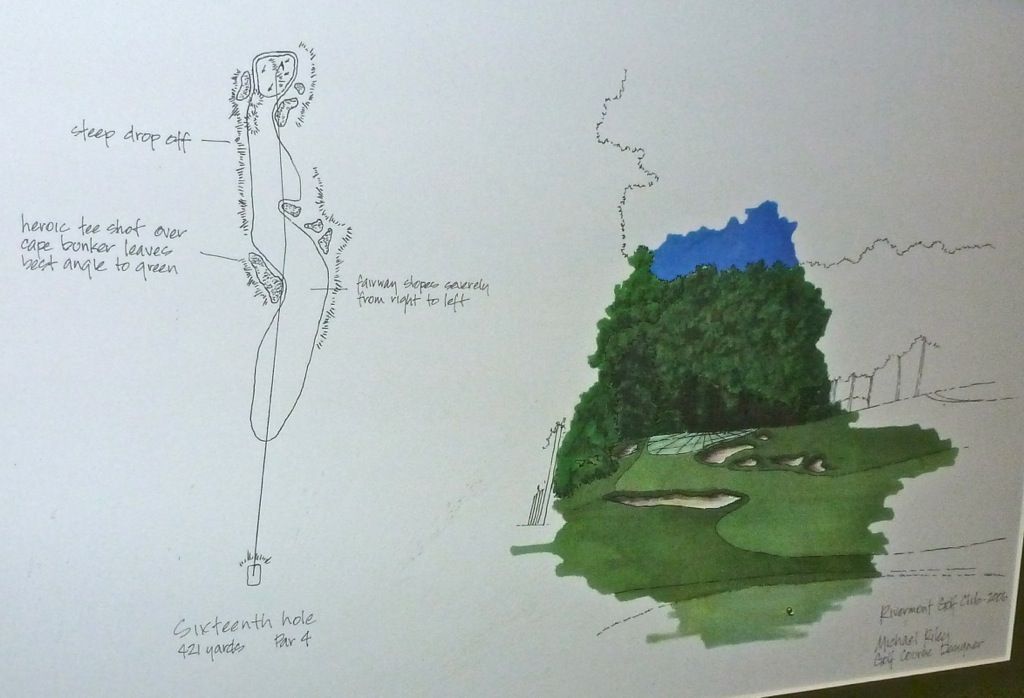
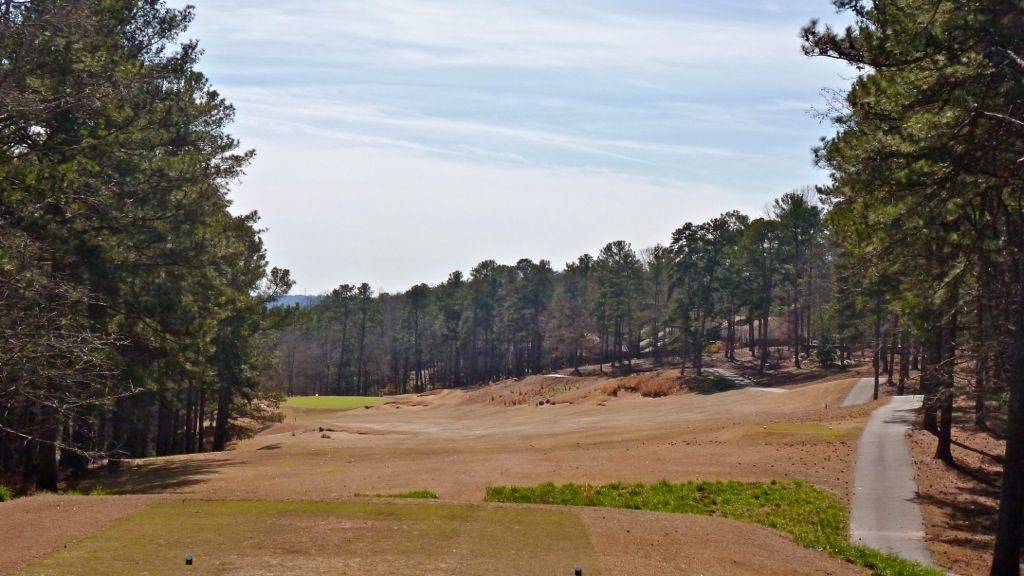
Golfers will do well to avoid a single well-placed bunker on the left to leave an approach to a green protected by a steep fall-off left and bunkering to the right.
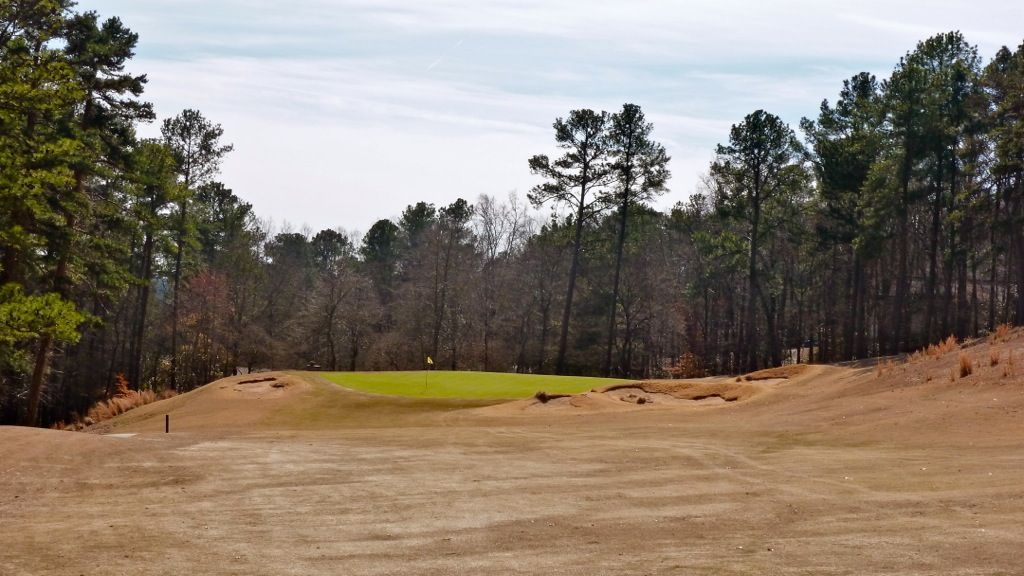
Note the right-to-left tilt of the land, as seen from behind the 16th green:

A dangerous drop-shot par-3 with a massive green.
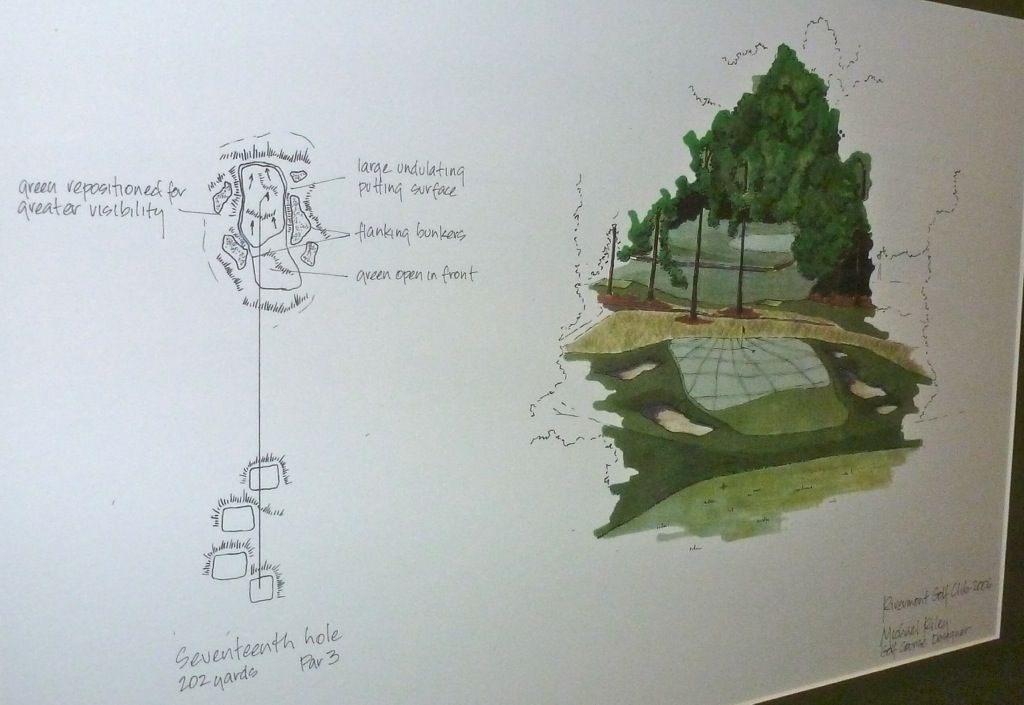
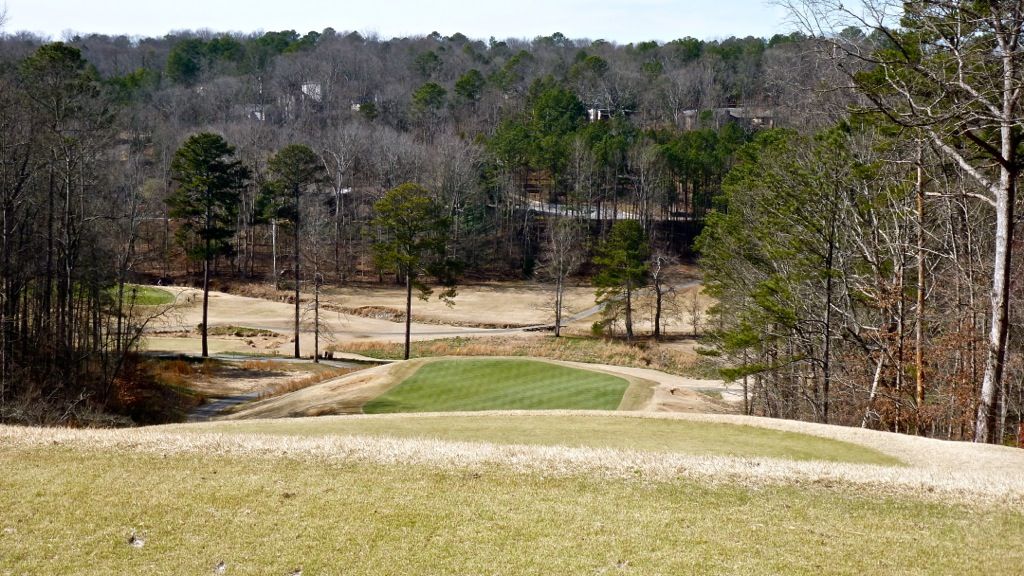
The hole played 195 yards on the day I played, and I was warned that long is the only terrible miss!
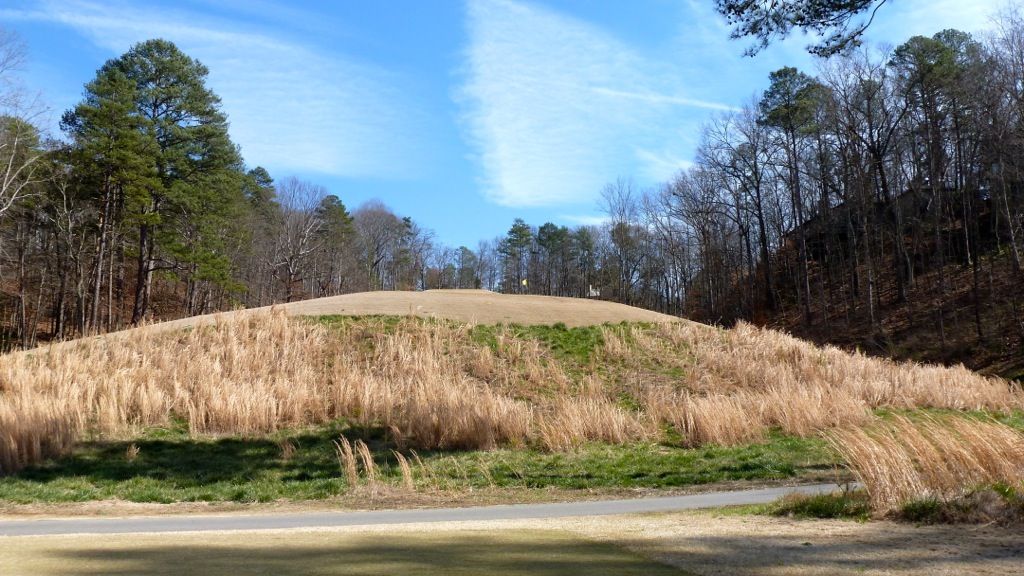

The 18th tee shot is one of the least dramatic on the golf course, where a tee shot played toward the fairway bunkers will leave a clear look at an open green front. A slope short-right of the green can be used to funnel balls onto the green, but hit its outside and the ball will kick well away to the right of the green.

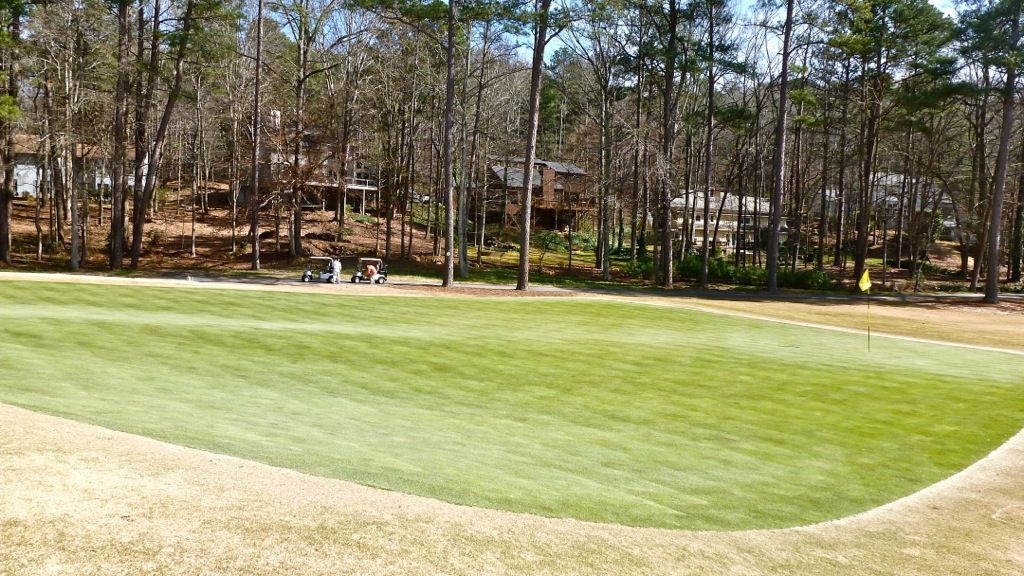
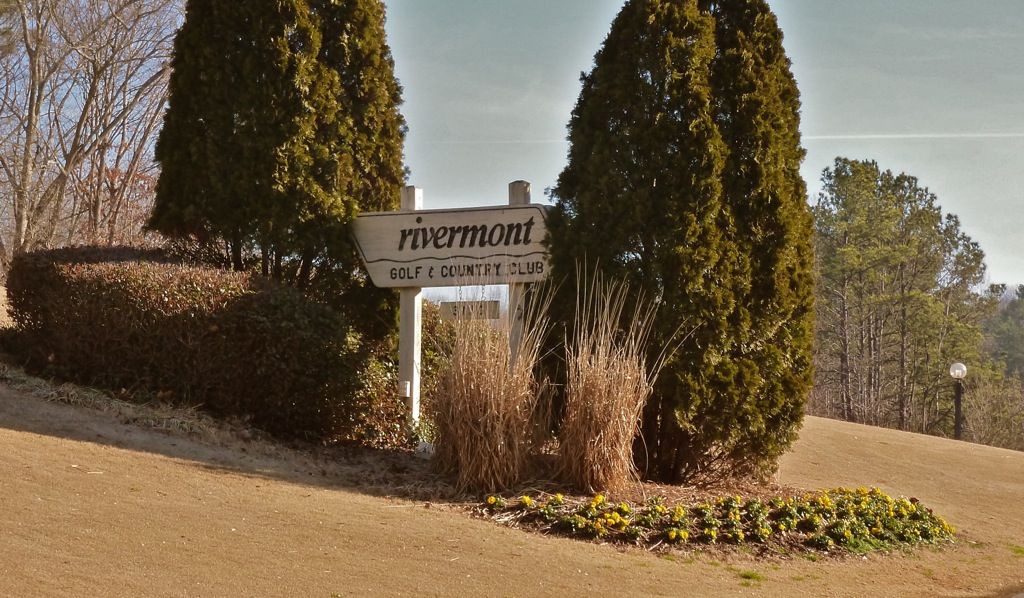
No comments:
Post a Comment